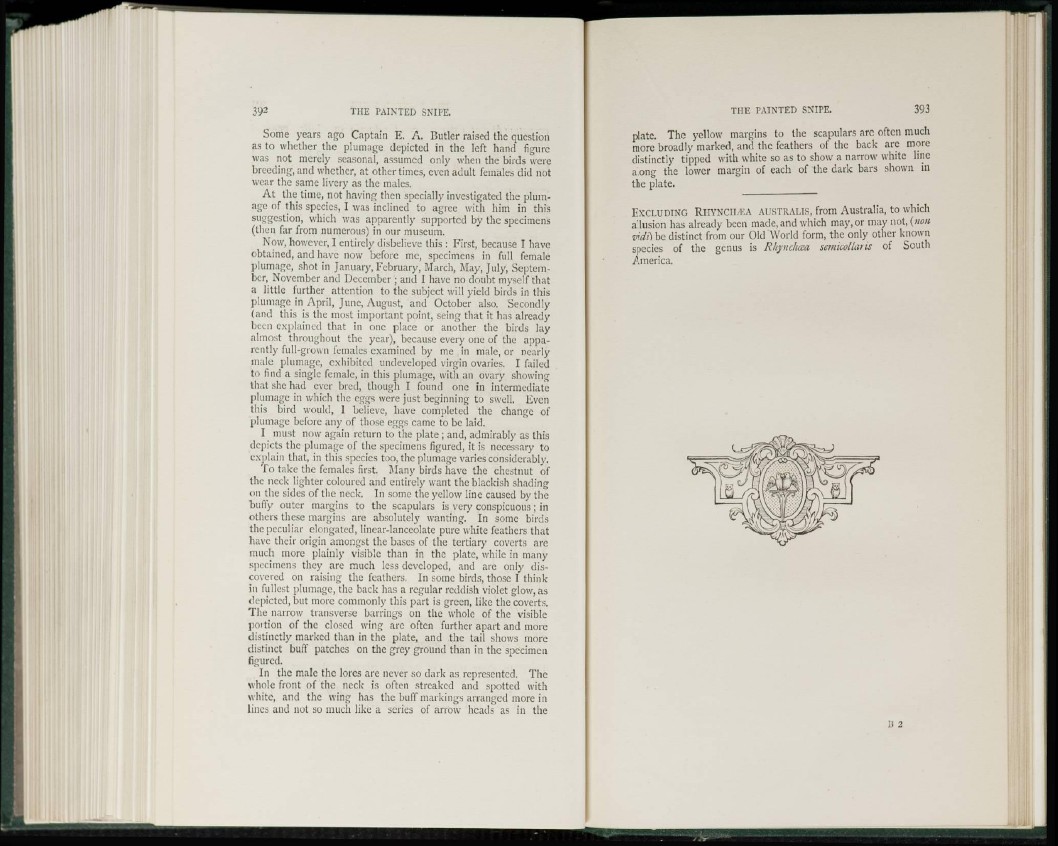
Some years ago Captain E. A. Butler raised the question
as to whether the plumage depicted in the left hand figure
was not merely seasonal, assumed only when the birds were
breeding, and whether, at other times, even adult females did not
wear the same livery as the males.
At the time, not having then specially investigated the plumage
of this species, I was inclined to agree with him in this
suggestion, which was apparently supported by the specimens
(then far from numerous) in our museum.
Now, however, I entirely disbelieve this : First, because I have
obtained, and have now before me, specimens in full female
plumage, shot in January, February, March, May, July, September,
November and December ; and I have no doubt myself that
a little further attention to the subject will yield birds in this
plumage in April, June, August, and October also. Secondly
(and this is the most important point, seing that it has already
been explained that in one place or another the birds lay
almost throughout the year), because every one of the apparently
full-grown females examined by me in male, or nearly
male plumage, exhibited undeveloped virgin ovaries. I failed
to find a single female, in this plumage, with an ovary showing
that she had ever bred, though I found one in intermediate
plumage in which the eggs were just beginning to swell. Even
this bird would, I believe, have completed the change of
plumage before any of those eggs came to be laid.
I must now again return to the plate ; and, admirably as this
depicts the plumage of the specimens figured, it is necessary to
explain that, in this species too, the plumage varies considerably.
To take the females first. Many birds have the chestnut of
the neck lighter coloured and entirely want the blackish shading
on the sides of the neck. In some the yellow line caused by the
buffy outer margins to the scapulars is very conspicuous ; in
others these margins are absolutely wanting. In some birds
the peculiar elongated, linear-lanceolate pure white feathers that
have their origin amongst the bases of the tertiary coverts are
much more plainly visible than in the plate, while in many
specimens they arc much less developed, and are only discovered
on raising the feathers. In some birds, those I think
in fullest plumage, the back has a regular reddish violet glow, as
depicted, but more commonly this part is green, like the coverts.
The narrow transverse barrings on the whole of the visible
portion of the closed wing arc often further apart and more
distinctly marked than in the plate, and the tail shows more
distinct buff patches on the grey ground than in the specimen
figured.
In the male the lores are never so dark as represented. The
whole front of the neck is often streaked and spotted with
white, and the wing has the buff markings arranged more in
lines and not so much like a scries of arrow heads as in the
plate. The yellow margins to the scapulars are often much
more broadly marked, and the feathers of the back are more
distinctly tipped with white so as to show a narrow white line
along the lower margin of each of the dark bars shown in
the plate.
EXCLUDING RIIYNCH/EA AUSTRALIS, from Australia, to which
allusion has already been made, and which may, or may not, (noil
vidi) be distinct from our Old World form, the only other known
species of the genus is Rliynchcsa semicoflaris of South
America.